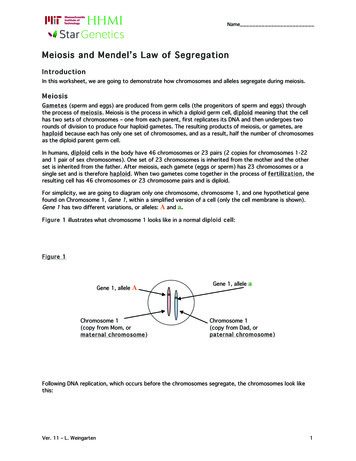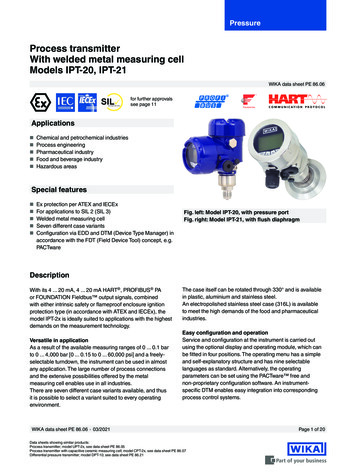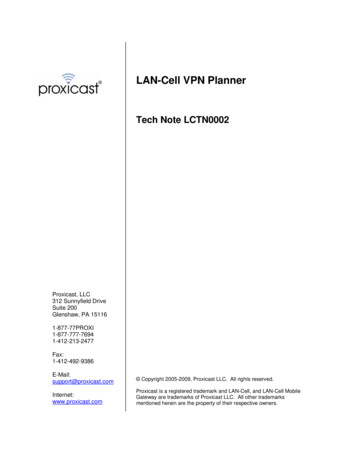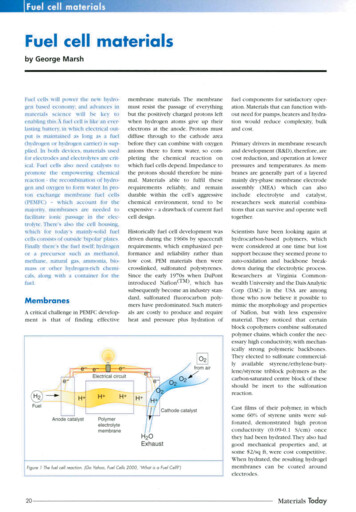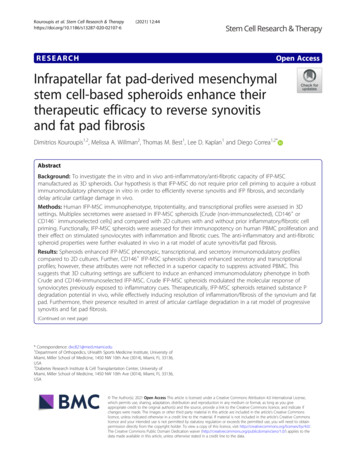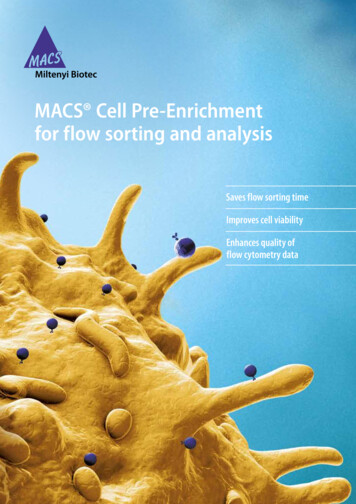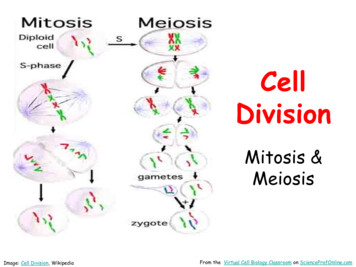
Transcription
CellDivisionMitosis &MeiosisImage: Cell Division, WikipediaFrom the Virtual Cell Biology Classroom on ScienceProfOnline.com
Eukaryotic Cell CycleLike prokaryotic cell cycle, in that – Cell grows.– DNA is replicated.- Mitotic cell divisionproduces daughter cellidentical to the parent.– The timing of replicationand cell division is highlyregulated.Image: Cell cycle by Richard WheelerFrom the Virtual Cell Biology Classroom on ScienceProfOnline.com
Eukaryotic Cell Cycle2 major phases: Interphase (3 stages)– DNA uncondensed Mitosis (4 stages cytokinesis)- Nuclear division & division ofcytoplasm– DNA condensedImage: Cell cycle by Richard WheelerFrom the Virtual Cell Biology Classroom on ScienceProfOnline.com
InterphaseNon-dividing stateWith 3 sub-stages:Gap 1 – cell grows in size– organelles replicatedSynthesis – replication of DNA– synthesis of proteinsassociated with DNAGap 2 – synthesis of proteinsassociated with mitosisImage: Cell cycle by Richard Wheeler; Interphase inOnion Cell Drawing & Photo, Source UnknownFrom the Virtual Cell Biology Classroom on ScienceProfOnline.com
MitosisDivision of somatic cells (non-reproductivecells) in eukaryotic organisms.A single cell divides into two identicaldaughter cells.Daughter cells have same # ofchromosomes as does parent cell.
Packing for the move When cell is not dividing DNA molecules in extended,uncondensed form chromatin Cell can only replicate andtranscribe DNA when in extendedstate.When cell is preparing fordivision DNA molecules condense toform chromosomes prior todivision.– each chromosome is a singlemolecule of DNA– easier to sort and organize thereplicated DNA into daughter cellsFrom the Virtual Cell Biology Classroom on ScienceProfOnline.com
Mitosis4 sub-phases:1st – Prophase2nd – Metaphase3rd – Anaphase4th – Telophasefollowed byCytokinesisImage: Mitosis diagram, Marek KultysFrom the Virtual Cell Biology Classroom on ScienceProfOnline.com
1. Prophase3 Major Events- chromosomes condense- spindle fibers form(spindle fibers are specialized microtubulesradiating out from centrioles)- chromosomes are capturedby spindleImages: Prophase drawing, Henry Gray's Anatomy of the Human Body;Prophase Onion Cell Drawing & Photo, Source Unknown, Fluoresced cell,National Institutes of HealthFluoresced eukaryotic cell.Chromosomes in blue. Mitotic spindleapparatus in green.From the Virtual Cell Biology Classroom on ScienceProfOnline.com
ingchromosomes
2. Metaphase chromosomes align alongequator of the cell, with onekinetochore facing each polecentrioleschromosomesspindle fibersKinetocores not pictured in this illustration.Images: Metaphase drawing, Henry Gray's Anatomy of the HumanBody; Metaphase Onion Cell Drawing & Photo, Source Unknown
3. Anaphase sister chromatids separate spindle fibers attached tokinetochores shorten andpull chromatids towards thepoles. free spindle fibers lengthenand push poles of cell apartImages: Anaphase drawing, Henry Gray's Anatomy of the HumanBody; Anaphase Onion Cell Drawing & Photo, Source UnknownFrom the Virtual Cell Biology Classroom on ScienceProfOnline.com
4. Telophase spindle fibers disintegrate nuclear envelopes form around bothgroups of chromosomes chromosomes revert to their extendedstate cytokinesis occurs, enclosing eachdaughter nucleus into a separate cellImages: Telophase drawing, Henry Gray's Anatomy of the HumanBody; Telophase Onion Cell Drawing & Photo, Source UnknownFrom the Virtual Cell Biology Classroom on ScienceProfOnline.com
Cytokinesis – Plant vs. Animal Cell Plant cells undergocytokinesis by forming a cellplate between the twodaughter nuclei. Animal cells undergocytokinesis through theformation of a cleavagefurrow. A ring of microtubulescontract, pinching the cell inhalf.Images: Telophase drawing, Henry Gray's Anatomy of the Human Body;Ciliate dividing, TheAlphaWolf; Telophase Onion Cell Photo, Source UnknownFrom the Virtual Cell Biology Classroom on ScienceProfOnline.com
Stages of MitosisREVIEW!Mitosis Animations1. Mitosis & Cytokinesis from McGraw-Hill2. Mitosis Interactive Animation from Cells AliveImage: Onion Cell Drawing & Photo, Source Unknown
Genetics TerminologySEXually reproducingeukaryotes, have 2 types of body cells Madeyoulook!1. somatic cells2. sex cells(a.k.a. gametes, germline)Image: Superficial human anatomy, Mikael Häggström&Rainer Zenz; Sperm & egg, WikipediaFrom the Virtual Cell Biology Classroom on ScienceProfOnline.com
What is cell division of gametes called?Meiosis- A single germ cell divides into four unique daughter cells.- Daughter cells have half the # of chromosomes as parentcell, so they considered haploid.Image: Overview of Meiosis,National Institutes of HealthFrom the Virtual Cell Biology Classroom on ScienceProfOnline.com
Genetics Terminology: PloidyRefers to the number of sets ofchromosomes in cells. Haploid – one copy of each chromosome– designated as “n”, the number ofchromosomes in one “set”- gametes Diploid – two sets of chromosomes- two of each chromosome– designated as “2n”- somatic cellsDiploid organisms receive one of each type ofchromosome from female parent (maternal chromosomes)and one of each type of chromosome from maleparent (paternal chromosomes)From the Virtual Cell Biology Classroom on ScienceProfOnline.com
Genetics Terminology: HomologuesChromosomes exist in homologous pairs indiploid (2n) cells.Exception: Sex chromosomes (X, Y).Other chromosomes, known as autosomes, theyhave homologues.From the Virtual Cell Biology Classroom on ScienceProfOnline.com
Karyotype Q: Which, of the top twokaryotypes is replicated? Q: How many homologouspair in each karyotype? Q: How is the bottomkaryotype different fromthe top two?From the Virtual Cell Biology Classroom on ScienceProfOnline.comImage: Karyotype, National Human Genome Research Institute
Sexual Reproduction Fusion of two gametes toproduce a single zygote. Introduces greatergenetic variation, allowsgenetic recombination. With exception of selffertilizing organisms,zygote has gametes fromtwo different parents.Images: Peter, Lois & Stewie, The Family GuyPeter Lois StewieFrom the Virtual Cell Biology Classroom on ScienceProfOnline.com
Sexual reproduction in humans At fertilization, 23 chromosomesare donated by each parent.(total 46 or 23 pairs). Gametes (sperm/ova):– Contain 22 autosomes and 1 sexchromosome.– Are haploid (haploid number“n” 23 in humans). Fertilization results in diploid zygote.– Diploid cell; 2n 46. (n 23 in humans) Q: Most cells in the body are produced through what type of celldivision? Only gametes are produced through meiosis.Image: Superficial human anatomy, MikaelHäggström& Rainer Zenz; Sperm & egg, WikipediaFrom the Virtual Cell Biology Classroom on ScienceProfOnline.com
Meiosis - Sex Cell (Gamete) FormationIn meiosis, thereare 2 divisionsof the nucleus:meiosis I&meiosis IIImage: Overview of Meiosis,National Institutes of HealthFrom the Virtual Cell Biology Classroom on ScienceProfOnline.com
REVIEW!Meiosis Animations2.1. How Meiosis Works from McGraw-HillMeiosis Interactive Animation from Cells AliveFrom the Virtual Cell Biology Classroom on ScienceProfOnline.comImage: Meiosis diagram, Marek Kultys
Meiosis & Sexual ReproductionLife CycleMitosis *From the Virtual Cell Biology Classroom on ScienceProfOnline.com**Image: Animal Life Cycle, Dr. T’s Bio 328 Genetics
Genetic Variation in Diploid Organisms Fusion of sperm and egg results inunique offspring. But not only because the young are aproduct of two individuals withdifferent genetic makeup. Meiosis “shuffles” the genes so thatthe an individual’s gametes aregenetically different from oneanother.How is this shuffling accomplished?From the Virtual Cell Biology Classroom on ScienceProfOnline.comImage: Meiosis diagram, Marek Kultys
Genetic shuffling of Meiosis IIn addition to a new combination of chromosomes resultingfrom fertilization, there are also events in Meiosis I thatshuffle the genes.1. Crossing overin Prophase I.2. Independent assortmentin Metaphase I.From the Virtual Cell Biology Classroom on ScienceProfOnline.com
Crossing Over Homologues break atidentical locations, thenrejoin opposite partners. This creates newcombinations of the alleleson each chromosome. Occurs randomly severaltimes on every chromosome. Results in mixing of thegenes you inherited fromyour parents.From the Virtual Cell Biology Classroom on ScienceProfOnline.com
Independent AssortmentREVIEW!Independent Assortment Animations2.1.Independent Assortment from Sinauer AssociatesRandom Orientation of Chromosomes During Meiosis from McGraw-Hill
Variation from geneticrecombination Independent assortment of chromosomes– meiosis introduces genetic variation– gametes of offspring do not have samecombination of genes as gametes from parents random assortment in humans produces223 (8,388,608) different combinations in gametesfrom Momfrom Dadoffspringnew gametesmade by offspring
Mitosis 2n Clone Same geneticinformation inparent cell anddaughter cell. Give me anotherone just like theother one!Meiosisvs. 1n Daughter cells different fromparent cell and from each other. Daughter cells have ½ thenumber of chromosomes assomatic cell. Shuffling the genes(Mix it up!) See animation “Unique Featuresof Meiosis” from McGraw-HillREVIEW!Animations Comparing Mitosis & MeiosisQuiz 1 and Quiz 2from McGraw-HillFrom the Virtual Cell Biology Classroom on ScienceProfOnline.com
Image: Mitosis diagram & Meiosis diagram, Marek KultysFrom the Virtual Cell Biology Classroom on ScienceProfOnline.com
Drawing and Labeling catedUncondensedChromosome(chromatin)From the Virtual Cell Biology Classroom on ScienceProfOnline.com
Drawing & Labeling Homologous m the Virtual Cell Biology Classroom on ScienceProfOnline.com
Confused?Here are links to fun resources that furtherexplain meiosis: Meiosis Main Page on the Virtual Cell Biology Classroom of “Meiosis: Where the Sex Starts”, video from Crash Meiosis animation, step-through and quiz, Sadava, et al., Life: The Meiosis step through animation from CellsAlive.com. Meiosis animation from McGraw-Hill. Independent Assortment animation from SinauerScience Prof Online.Course BiologyScience of Biology, 9th Edition, Sinauer Associates.Associates.From the Virtual Cell Biology Classroom on ScienceProfOnline.com
Are you feeling blinded by science?Do yourself a favor. Use the Virtual Cell BiologyClassroom (VCBC) !The VCBC is full of resources to help you succeed,including: practice test questions review questionsstudy guides and learning objectivesPowerPoints on other topicsYou can access the Virtual Cell Biology Classroom (VCBC) on the Science Prof Onlinewebsite www.ScienceProfOnline.comImages: Blinded With Science album, Thomas Dolby; Endomembrane system, Mariana Ruiz, Wiki
Images: Prophase drawing, Henry Gray's Anatomy of the Human Body; Prophase Onion Cell Drawing & Photo, Source Unknown, Fluoresced cell, National Institutes of Health 3 Major Events - chromosomes condense - spindle fibers form (spindle fibers are specialized microtubules radiating out from centrioles) - chromosomes are captured by spindle apparatus in green. From the Virtual Cell Biology .
